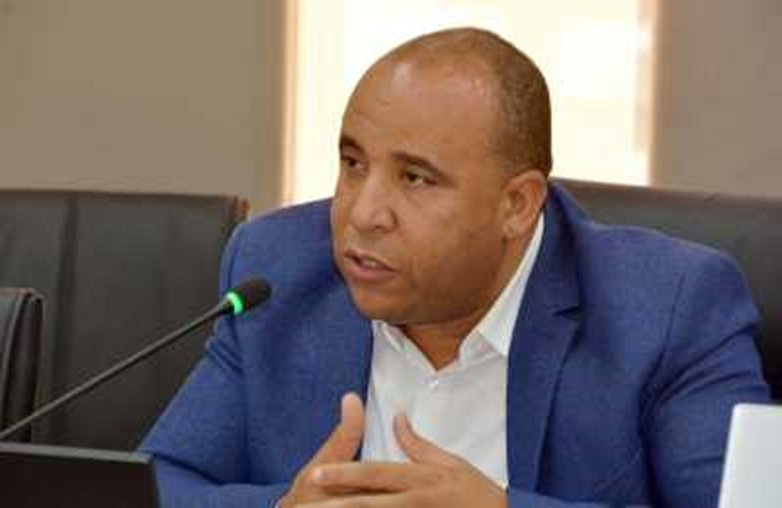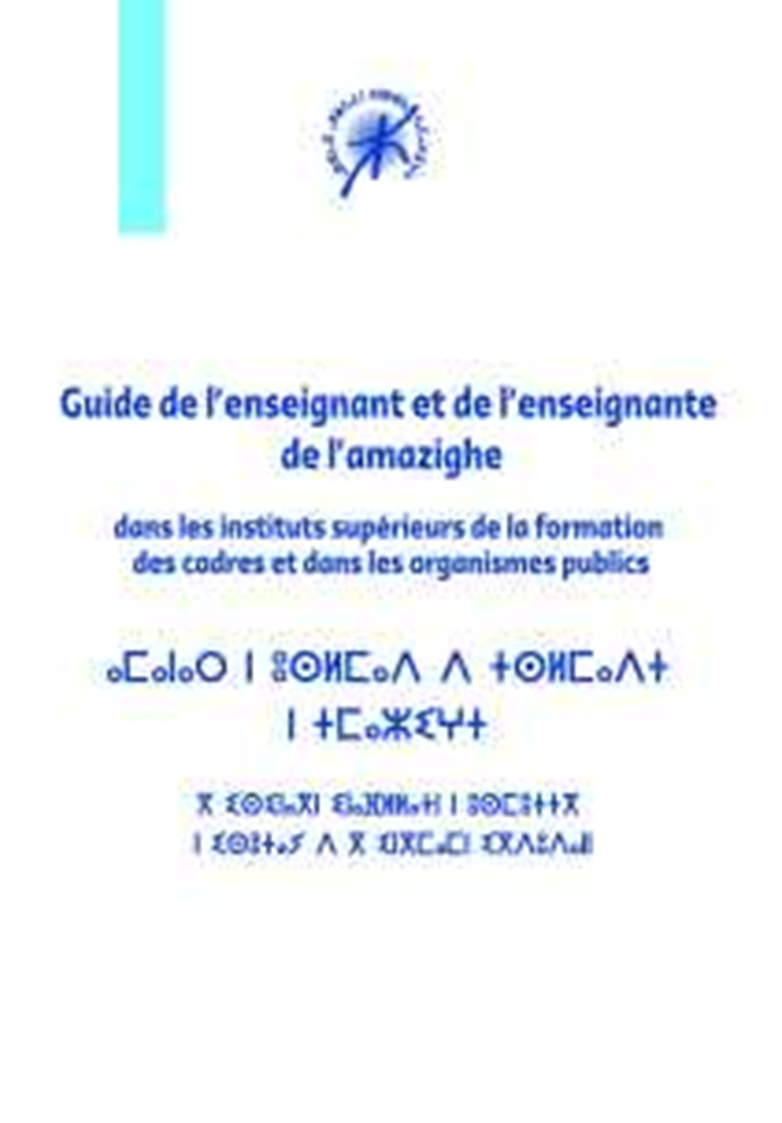Dialogue with D. Kamal Aqa is a researcher at the Center for Didactic Research and Pedagogical Programs

The guide aims to develop and strengthen the capabilities of its users with regard to teaching the Amazigh language
Q ① : In the beginning, we knew who Kamal Aqa was? Brief us about your academic path and your tasks within the center.
First of all, allow me to introduce you, Mr. Mohi Mkhlis, for this hosting. I would also like to thank you for the efforts made and still being made to introduce the Amazigh culture and language and its academic achievement. As a brief introduction, I am Kamal Aqa, 45 years old, born in Tamerdoulat Asrir Palace in Tangdad, Errachidia. I continued my studies at the primary level at the Musa Ben Nusayr group of schools in Amalal, after which I joined Al-Wahda Preparatory School, then Hassan II Secondary School in Tangdad, where I obtained the baccalaureate in the Modern Arts Division in 1998, to join... Then, at the Faculty of Arts and Human Sciences at Moulay Ismail University of Meknes, where I spent 11 years, culminating in obtaining a doctorate in applied linguistics and information and communication technology, on the subject of preparing local bilingual dictionaries, Arabic and Amazigh. After that, I joined the Royal Institute of Amazigh Culture as a researcher at the Center for Didactic Research and Pedagogical Programs to work with a group of my colleagues in the field of preparing educational tools to assist in teaching and learning the Amazigh language, such as the pedagogical kit for the common departments in coordination with the Center for Educational Renewal and Experimentation, and educational guides directed to teachers of primary education and those directed to professors who wish to In teaching Amazigh to adults, school dictionaries, and preparing digital resources, in addition to my contribution in preparing evaluative studies questioning the level of inclusion of the Amazigh language in Moroccan schools, whether at the level of achievement or at the level of classroom practice, without forgetting my contribution with my colleagues at the center in training educational actors in the latest developments. Educational research in the Amazigh language, in coordination with the central and regional administrators of the Ministry of National Education.
Q 2 : What are the goals behind the center to which you belong issuing the “Teacher and School Guide for the Amazigh Language in Higher Institutes and Public Institutions”?

Continuing to carry out and carry out the tasks entrusted to it according to the words of the Dahir issued to it, the Royal Institute of Amazigh Culture assigned great importance to the field of teaching and learning the Amazigh language to non-native speakers, which was essentially represented, even before the preparation of the guide for teachers and schools of the Amazigh language in higher institutes and public institutions, in its programming of a number From language and communication lessons in Amazigh for adults who speak other languages, and free of charge, a significant number of Moroccans and foreigners benefited from it between 2008 and 2013. As a culmination of this path, it was necessary to think about preparing the didactic tools accompanying the teaching of the Amazigh language to adults, which first began with the preparation of the series “Sawlat s Tamazight” in the three linguistic branches of Trivet, Tamazight and Challahit, followed by the preparation of this guide that seeks to contribute to the radiance of the Amazigh language at the national level. As an official language of the Moroccan state alongside the Arabic language, this is done by providing teachers who wish to teach Amazigh to adults in training institutes, public institutions and various groups of non-Amazigh-speaking adults with a guide that facilitates the process of achieving and accomplishing the task assigned to them.
?Q ③ : What methodology did you adopt in completing it
It is a work directed, as I said, to teachers of the Amazigh language practicing in higher training institutes and in public institutions. However, it can be employed and used to teach this language to any individual who wishes to learn it. It has been developed, reviewed, and supplemented based on the experience of many years of teaching the Amazigh language for the benefit of adults and students of higher institutes for training frameworks, relying on a set of reference texts, especially the directives of the newly created and organized Dahir of the Royal Institute of Amazigh Culture and the new status of the Amazigh language as an official language of the state, in addition to... The Arabic language (see Chapter Five of the Constitution of Morocco, 2011); And the Prime Minister’s Circular No. 05/2017 related to “Teaching the Amazigh language in higher institutions and institutes,” through which he recommends that the government sectors that supervise these institutions and institutes, and in coordination with the Royal Institute of Amazigh Culture, develop training programs to learn the Amazigh language for students and frameworks that follow up on training. Within these institutes; Framework Law No. 51.17, dated August 9, 2019, relating to education, training and scientific research, which was drafted based on the strategic vision for reform 2015-2030; And Regulatory Law No. 26-16, dated September 26, 2019, specifying the process of activating the official nature of the Amazigh language, as well as the various forms of its inclusion in education and priority public areas; And Regulatory Law No. 04-16 of April 2, 2020 relating to the National Council for Moroccan Languages and Culture, whose tasks include developing a strategic vision and general directions for the benefit of the state with regard to linguistic and cultural policy and working to protect and develop the two official languages, Amazigh and Arabic.

The guide generally aims to develop and strengthen the capabilities of its users with regard to teaching the Amazigh language, by providing them with a methodology that combines what is theoretical and what is applied at the same time. The procedural goal of this guide is to provide its users with elements to answer the following questions: What contents are taught and for what educational level? What competencies are developed? How can linguistic aspects be addressed, especially those related to the lexicon, grammar, morphology, and spelling? How can the written/oral relationship be approached? How are oral comprehension, oral production, written comprehension and written production taught and assessed? The answers to these questions are reinforced through practical excerpts that serve as supports for the purpose of preparing lessons.
The goal was not to impose a model methodology, as much as the effort of this section was to present methodological directions supported by a set of pedagogical fragments and evaluation networks that would develop and evaluate the oral and written competence of male and female learners according to the theoretical framework that draws its foundations from the competency approach, the action approach, and the project pedagogy. And the pedagogy of inclusion.
This guide consists of three sections. The first section is titled “Developing Handwriting/Writing Proficiency”, introducing the Tifinagh-Erkham letter, spelling rules, and verbal chain segmentation. The second section deals with “Developing communicative and cultural competence.” It proposes a study program and pedagogical organization for the learning of levels 1 and 2. It also presents the general foundations and directions of the didactic model adopted by this organization, along with an inventory and specification of the reference for the final interim competencies to be developed, as well as the resources that must be installed and the tasks to be performed by the male/female learners in Each lesson and during each stage or level is specific to specific competencies

Regarding the third section, entitled: “Pedagogical Resources,” it contributes to providing male and female teachers with content in order to develop the linguistic competencies of male and female learners, such as subject glossaries, phrases, and grammatical and morphological elements. In addition, this section places at the disposal of professors a set of supports in the form of dialogues and reading texts according to the academic level, the lesson, and the stage of each competency.
This work has been appended with bibliographic references, the aim of which is to provide a working tool that enables each user to adapt and enrich it according to his experience.
?Q ④ : What can you add regarding educational practices
This study, which is a publication of the Royal Institute of Amazigh Culture in 2022, was launched from a pivotal question: How is the process of teaching reading in the Amazigh language carried out at the didactic and pedagogical levels in the fourth and sixth levels of primary education?
The purpose of completing this study is to know the extent to which the teacher has developed the reading strategies of male and female learners in the Amazigh language at the fourth and sixth levels. In order to achieve this goal, a methodology based on real-time classroom observation of the educational process was relied upon, with semi-directed interviews being conducted. With the professors involved in the study. Therefore, this study worked on a sample of teachers of the Amazigh language who practice their duties at the fourth and sixth levels of primary school. Their number reached 30 male and female teachers distributed among six regional academies of education and training. This study adopted a number of tools in order to collect its data, which was a network to observe the methodology adopted by the professor in developing reading strategies among learners in the fourth and sixth levels. This network was built based on a competency reference framework that is consistent with the contents of Amazigh language books and pedagogical guides at the fourth and sixth levels of primary education.
In order to deepen the analysis and interpret the results that will be reached through observation, a semi-directed questioning was adopted with the professors concerned with the observations at each of the two aforementioned educational levels.
?Q ⑤ : Are there any future projects for the center
As a contribution to implementing the requirements of the regulatory law on activating the official nature of the Amazigh language, the Center for Didactic Research and Pedagogical Programs has programmed, in its work program, the preparation of a training formula directed at those wishing to teach the Amazigh language to adults. It is a formula that will strengthen the evidence that we talked about previously. It has also programmed the preparation of several didactic holders and aids. As well as digital resources to help teach the Amazigh language in Moroccan schools, in coordination with a number of creative, practicing professors, without forgetting to supplement the basic research with academic studies, including collective research centered on the textbook for the Amazigh language, its construction, evaluation, and prospects for its development.

-last word.
I once again thank your newspaper for its continued interest in introducing the academic achievement of the Royal Institute of Amazigh Culture, reiterating that the Center for Didactic Research and Pedagogical Programs is determined to actually contribute to the preparation of curricula and programs for teaching the Amazigh language at the primary, middle and secondary levels of education and literacy programs in the Amazigh language. This is stipulated in Framework Law 51-17, Regulatory Law 26-16 and the governmental obligations expressed in this regard.
Achieved by: Moha Mkhleis

